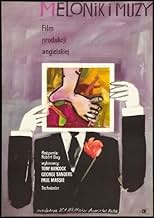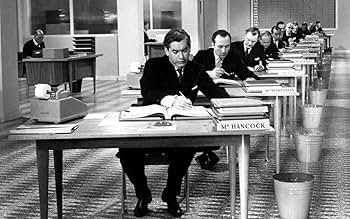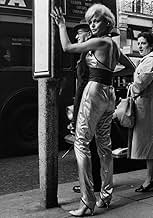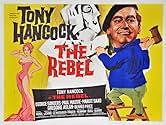IMDb-BEWERTUNG
6,8/10
1257
IHRE BEWERTUNG
Füge eine Handlung in deiner Sprache hinzuTony Hancock gives up his day job to become an artist. He's a lot of enthusiasm, but little talent, and critics dislike his work. Nevertheless, he impresses a talented artist.Tony Hancock gives up his day job to become an artist. He's a lot of enthusiasm, but little talent, and critics dislike his work. Nevertheless, he impresses a talented artist.Tony Hancock gives up his day job to become an artist. He's a lot of enthusiasm, but little talent, and critics dislike his work. Nevertheless, he impresses a talented artist.
- Nominiert für 1 BAFTA Award
- 1 Nominierung insgesamt
Gary Cockrell
- Artist
- (as Gary Cockerill)
Empfohlene Bewertungen
Despite the fact that it's written by Tony himself with Galaton and Simpson's assitance, and that it's beginning and ending are set at the hotel where Hancock resided in the last season, this film feels quite different from "Hancock's Half hour".
However it overcomes it's shortcomings, has a good number of laughs with snappy one-liners and makes me look foward to seeing "The Punch and Judy man" ( another Hancock film ).
7.5/10
( Rated G/U due to the absence of offensive content )
However it overcomes it's shortcomings, has a good number of laughs with snappy one-liners and makes me look foward to seeing "The Punch and Judy man" ( another Hancock film ).
7.5/10
( Rated G/U due to the absence of offensive content )
It was a natural step for Tony Hancock in attempting to become successful in the medium of cinema. He longed for success in America and the only way he might have achieved this, was by making tailor-made films. "The Rebel" was the result. The year of the film's release - 1961, saw Hancock at the peak of his popularity in Britain. At one stage, about 23% of the British population were either tuning into his radio series or were watching him on television. Such an achievement is seldom. "The Rebel" is a very good effort and I always enjoy the film. For the first time in his distinguished career, Hancock appeared in technicolour after four years of performing in black and white. I shall forever recall my inital surprise and slight bewilderment at seeing this comedy legend in colour. It took me a while to adapt to seeing Hancock in anything except monochrome. The story wisely has the comedian playing the same character of 23 Railway Cuttings and with the identical character traits. Hancock is wanting to better himself after feeling he has denied himself his true potential and calling in his life. He has endeavours in wanting to become a painter and so, he leaves his job as an office clerk and moves to Paris. Whilst there, "The Lad Himself" meets a fellow struggling artist and they share digs, hoping that success might beckon. It does but in ways Hancock never expected...... I am glad that Ray Galton and Alan Simpson wrote the script as who better to write for Hancock than those two individuals? The comedian collaborated with the writers on the story and whose name is listed during the opening credits under story. There are some great scenes here, such as watching Hancock attempting to paint various buildings around Paris, befriending the Avant Garde characters, getting mixed up with a criminal mob and other highlights. Watching "The Rebel," I sense a kind of loneliness with Hancock in his character. The way he has no family to speak of, not many friends, feeling somewhat dissatisfied with his lot in life, embarking upon his adventures in Paris alone and not knowing a single soul in France anywhere. However, he comes across as self-reliant, independent and determined to realise his dream as an artist. This film would mark the final time that Tony Hancock worked with Ray Galton and Alan Simpson. One of the most talented and successful collaborations in British comedy history would draw to a close. The film did respectable business at the British box office and a Gala reception was held in London for the films release. Unfortunately, America took little notice. Their loss! I highly recommend this film to anyone who is a fan of Hancock or of British comedy in general.
An often overlooked and underrated Hancock vehicle as the Lad from East Cheam inadvertently becomes the toast of the art world when his flatmate's paintings are accidentally attributed to him instead of his own primitive childish daubs.
Great ensemble cast with John Le Mesurier as his boss, the sublime Irene Handl as his landlady Mrs Cravat and George Sanders as his pompous artistic agent.
At the films' centre is a sharp and nicely played critique of the hypocrisy and snobbishness of the art world with the usual taut Galton and Simpson script full of smart one liners.
"What's that?" asks Mrs Cravat looking at a bright pink picture of a man in a beret. "It's a self portrait" replies Hancock. "Who of?" counters Mrs Cravat.
Look out for a very young Nanette Newman as an Existentialist acolyte in the party scene and also Oliver Reed as a cafe artist.
8/10
Great ensemble cast with John Le Mesurier as his boss, the sublime Irene Handl as his landlady Mrs Cravat and George Sanders as his pompous artistic agent.
At the films' centre is a sharp and nicely played critique of the hypocrisy and snobbishness of the art world with the usual taut Galton and Simpson script full of smart one liners.
"What's that?" asks Mrs Cravat looking at a bright pink picture of a man in a beret. "It's a self portrait" replies Hancock. "Who of?" counters Mrs Cravat.
Look out for a very young Nanette Newman as an Existentialist acolyte in the party scene and also Oliver Reed as a cafe artist.
8/10
For anybody with a love for Handcock this film is a must see. For those who really know Handcock it is also a farewell as in many ways it could be seen as his last true work? Coming at a time when Handcock was desperately trying to re-invent himself and re mould his style whilst fighting off the blackness of depression the film is a mixture of hope and sadness. If you look behind the laughter and mirth you can see Hancock as he really is - a one of genius never to be repeated. Hancock plays a struggling artist who leaves his London office job to seek his fame and fortune in Paris. Look for the great line between himself and his Landlady Mrs Cravat when Hancock exclaims "Its a self portrait" Mrs Cravat looks and him and asks "Of who?" Handcock is at the end of his line "Who do you think Laurel and Hardy" Lol The film has the usuall Galton and Simpson tight story line and the action is very funny. In my opinion a film which in ever way is on a par with the carry on style genre. Enjoy you wont see the likes of Tony again!
I remember seeing The Rebel, on general release, in Croydon - three or four miles from where the railway scenes were shot: a bygone branch line and now demolished station off Coombe Road. (We used to walk past it a couple of times each week in the 1950s in the Elmhurst 'crocodile' to play sports at Lloyd Park. Happy days, indeed.) Unfortunately, I have never been very comfortable with the film - and I have persevered with it over the years. The Hancock attitude quickly wears thin and the script is simply below par for these writers. Best scenes, apart from the nostalgia element, are those with Irene Handl; Margit Saad (best known to me from Magnificent Two)is easy on the eye, as ever, but must have been embarrassed with her banal Margot character.
Nevertheless, I am pleased that the picture has its adherents. Where is Margit Saad today? A directorial credit around 1990 and seemingly nothing since.
Nevertheless, I am pleased that the picture has its adherents. Where is Margit Saad today? A directorial credit around 1990 and seemingly nothing since.
Wusstest du schon
- WissenswertesThe film was a critical and commercial disaster in the United States.
- PatzerWhen the two bodyguards appear on the luxury yacht their shirts are buttoned and unbuttoned showing vests underneath.
- Crazy CreditsThe producers wish to acknowledge the fullest co-operation accorded - somewhat apprehensively - by BRITISH RAILWAYS.
- VerbindungenEdited into Urban Myths: Les Dawson's Parisienne Adventure (2020)
- SoundtracksAt Last ! At Last !
(L'Âme des Poètes)
(uncredited)
Music by Charles Trenet
French lyrics by Charles Trenet
English lyrics by Florence Miles
Top-Auswahl
Melde dich zum Bewerten an und greife auf die Watchlist für personalisierte Empfehlungen zu.
- How long is Call Me Genius?Powered by Alexa
Details
- Erscheinungsdatum
- Herkunftsland
- Sprachen
- Auch bekannt als
- Call Me Genius
- Drehorte
- Bingham Road railway station, Addiscombe, Croydon, London, England, Vereinigtes Königreich(Fortune Green South Station)
- Produktionsfirma
- Weitere beteiligte Unternehmen bei IMDbPro anzeigen
- Laufzeit1 Stunde 45 Minuten
- Seitenverhältnis
- 1.66 : 1
Zu dieser Seite beitragen
Bearbeitung vorschlagen oder fehlenden Inhalt hinzufügen




































